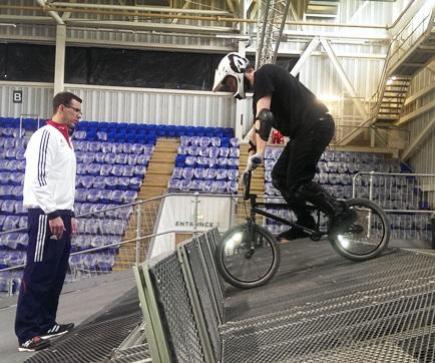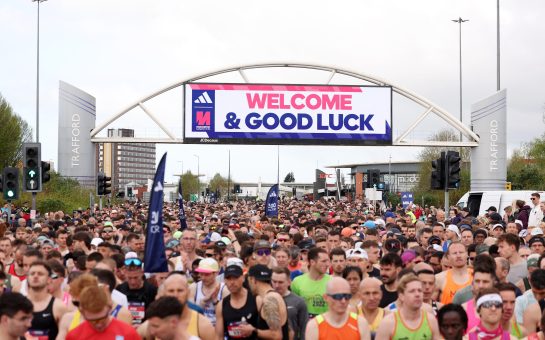BMX star Liam Phillips has described British Cycling’s custom-built facilities in Manchester as the best in the world as he prepares for the UCI BMX World Championships in July.
The 26-year-old moved to Manchester seven years ago, and has since represented Great Britain at two Olympic Games and earned his first rainbow jersey at the 2013 UCI BMX World Championships.
He is currently preparing for the July 21-25 World Championships to be held at Circuit Zolder in Belgium, a site better known for its Formula 1 pedigree.
At a special track day, where Phillips and BMX team coach Grant White gave out a few pointers on BMX riding, the talented athlete spoke about the world class facilities available in Manchester.
“With the facility, it is the world leader. It’s the best facility in the world and we’re super lucky to be able to train here every day,” he said.
Even with the Olympics in Rio de Janeiro a year away and the on-going BMX World Cup events throughout the year, Phillips’ preparation is focussed on the upcoming competition.
The Championships are taken seriously by competitors, with a legendary rainbow jersey up for grabs to the winner.
“For me wearing the rainbow jersey, that is the absolute top of the tree for me,” said Phillips.
“Obviously the Olympics is what we’re all here for and what we all strive for, but to wear that rainbow jersey, that’s something I’ve aspired to do for years and years.”
Phillips moved to Manchester in 2007, where he lived with two other then teenage sensations, World Cup winning track cyclist Matthew Crampton and Olympic Gold-medallist Jason Kenny.
The trio were the first cyclists to move to Manchester, and Phillips was able to see first-hand the development of the facilities at the Velodrome.
“At the time there wasn’t even a BMX track, indoors, outdoors, in Manchester there wasn’t one,” he told MM.
“So I made the commitment to move here basically just to work with the experts that work for British Cycling.
“Then over-time we’ve had an indoor facility built, which is mind-blowing, and we had other outdoor facilities built.”
British Cycling coach Grant White, who was also on hand at the track day to show MM how it’s done, echoed his charge’s sentiments.

‘DOWNRIGHT TERRIFYING’: British BMX coach Grant White puts MM’s Lewis Chapman-Barker through his paces
White said: “The facilities at the National Cycling Centre have been a real game changer for all of our BMX riders.
“You only have to see the success that riders like Liam has had over the last couple of years to see how much having a facility like this at our disposal can improve performances.
“It enables us train all year round, whatever the weather conditions.”
White also spoke of the impact that uniting everyone in one facility has had on the sport.
“It’s fantastic to have us all under one roof. The inspiration provided by everyone in the building whether that’s someone on the track or the BMX riders, I think everyone’s success spurs each other on.
“You only have to see the effect that Liam’s success has had on riders like Kyle Evans and Tre Whyte and how it has spurred them on to try and reach his level to see the impact success can have.”
The tailor-made track and training centre now homes cyclists from across several disciplines, making Manchester the place to be for serious cyclists.
“Now, the programme as a whole, it is a centralised programme,” added Phillips.
“So if you are to be part of the British Cycling BMX programme or Track Cycling programme, you have to live in Manchester.
“Any athlete that would opt to do otherwise, they wouldn’t do that because you walk in here every day and I’m stood here talking now and this is our doctor just come in to check on use.
“Every single person that we work with is here every day. The facilities are one thing, but also the support staff that we have access to, it’s a no-brainer to be based here.”
With so many competitive athletes under one roof, the comradery amongst the British Cycling team enables each of them to feed off of each other’s performances.
“We all work alongside each other, and thrive off one another,” said Phillips.
“I train in the gym with the track sprinters, you know. We’re all under one roof, and we’re working together side by side.”
BMX is one of the lesser-known cycling disciplines, with many people thinking of the freestyle BMX street-riders more familiar to X-Games viewers rather than the competitive racing discipline.
Phillips explained that while his colleagues understood and respected BMX motocross, public notions about the sport haven’t always been on point.
“To be honest, I think that maybe not so much from the athletes but certainly from the public, everybody’s perception of BMX was a little bit wayward I think at times,” he said.
“But with the facility that have got now, and the fact that people can actually come and see what we do, it’s given the sport real credibility.
“I think that my progression and success over the last five years has certainly solidified our place in this programme.
“We’re here to be world and Olympic champions just like everybody else.”
That progression in the sport is underlined not only by the use of high-tech equipment to monitor performance, but by the constantly changing structure of the track at the velodrome.
Featuring an imposing five metre tall start ramp, and a downright terrifying eight metre ramp, the BMX track features three banked corners and a series of jumps and bumps to keep riders on their toes.
“Everything does change, the tracks that we race on change,” said Phillips.
“There’s not a set track or lap, and even since this facility’s been built the track has been changed so many times that what was the lap record even 12 months ago is completely irrelevant now because the track is completely different.”
The state of the art equipment available to athletes at the National Cycling Centre now includes sensors from British Aerospace Systems which can track a rider’s movements throughout the track.
This kind of analysis goes beyond simple lap times, giving coaches and riders an idea of how each sector is affecting performance.
In a sport where winning can come down to the difference of hair’s width, White clearly felt this input was invaluable.
He said: “The BAE system allows us to analyse performance in a way that we’ve never been able to in the past.
“For example we now know exactly how long it takes our riders to reach the bottom of the start ramp.
“Liam has made the smallest gain there over the last 12 months, but come race day that can be the difference between first and second place.”
Phillips was keen not to understate the potential of the technology, saying: “The BAE stuff we’ve only had for literally a couple of months, so we know that it’s going to make a massive difference to be able to see how much of an impact different techniques and different things have across the first jump.
“That’s such an important part of the race that. Aside from the start hill, that is actually the most important jump on the track because you can distance yourself from the competition.”
The spectacular track is open to the public like any other facility: with special ‘Strider’ sessions for kids aged just two or three years old finishing just before the Team GB athletes get on the track.
Phillips spoke about his hopes for seeing a future Olympic star walk through the doors at the Velodrome, saying: “It’s amazing, if there was to be an Olympic champion to come through the doors here.
“This could be somewhere where we take a kid almost off the street and get them in, on a bike, and they could go to the Olympics.”
Taming the track at the velodrome would be no mean feat for anyone, but athletes like Phillips make it look it easy.
Main image courtesy of British Cycling via YouTube, with thanks.



